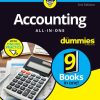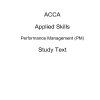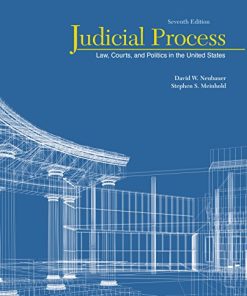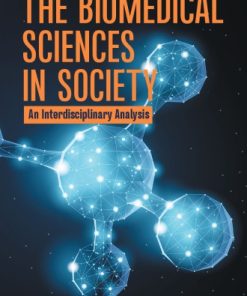(EBook PDF) The Audit Process 7th Edition by Iain Gray, Louise Crawford, Stuart Manson 1473760186 978-1473760189 full chapters
$50.00 Original price was: $50.00.$25.00Current price is: $25.00.
The Audit Process 7th Edition by Iain Gray, Louise Crawford, Stuart Manson – Ebook PDF Instant Download/DeliveryISBN: 473760186, 978-1473760189
Full dowload The Audit Process 7th Edition after payment.
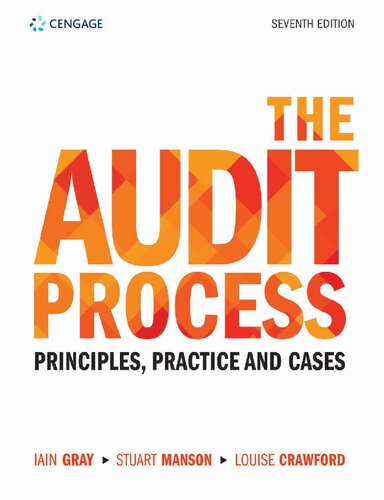
Product details:
ISBN-10 : 1473760186
ISBN-13 : 978-1473760189
Author: Iain Gray, Louise Crawford, Stuart Manson
The Audit Process provides an essential introduction to the principles and practices of auditing. This accessible textbook guides students through every step of the audit process and provides plenty of opportunities to practise what they are learning. Completely updated in line with the latest standards, regulatory processes and corporate governance, the seventh edition of this comprehensive text is ideally suited for auditing modules taught on undergraduate and postgraduate courses in accounting and finance.
The Audit Process 7th Table of contents:
Chapter 1: Why Are Auditors Needed?
Opening Remarks
Basic Principles: Introduction through a Simple Case
Justification of Audit
Introduction to Truth and Fairness in Accounting
Basic Audit Framework
Some Initial Ideas on an Extended Role for Audit
Assurance Services
Summary of Principles
Definition of an Audit of Financial and Other Information
Current Developments
Summary
Key Points of the Chapter
References
Further Reading
Self-Assessment Questions (Solutions Available to Students)
Self-Assessment Questions (Solutions Available to Tutors)
Topics for Class Discussion without Solutions
Chapter 2: An Overview of the Postulates and Concepts of Auditing
The Importance of Theory and Concepts in Underpinning Auditing Practice
The Postulates of Auditing
The Concepts of Auditing: Credibility, Process, Communication, Performance
Introduction to the Audit Expectations Gap
Introduction to Audit Quality
Introduction to Corporate Governance
Public Interest
The Layers of Regulation and Control
Summary
Key Points of the Chapter
References
Further Reading
Self-Assessment Questions (Solutions Available to Students)
Self-Assessment Questions (Solutions Available to Tutors)
Topics for Class Discussion without Solutions
Chapter 3: The Meaning and Importance of Auditor Independence: Factors Affecting Independence and Me
Introduction
Independence and the Role of Audit
Definitions of Independence
Practitioner and Profession Independence
Conflict, Power of Auditor and Client and Effect on Perceived Independence
Published Codes of Ethics
Audit Firm’s Control Environment
Safeguards to Counter Threats to Integrity, Objectivity and Independence
Small Entities
Summary
Key Points of the Chapter
References and Further Reading
Self-Assessment Questions (Solutions Available to Students)
Self-Assessment Questions (Solutions Available to Tutors)
Topics for Class Discussion without Solutions
Chapter 4: Audit Regulation
The Need for Regulation
The UK Regulatory System
The Current Regulatory System
The Role of the RSBs and RQBs in the Regulation of Their Members and Registered Audit Firms
European Union Influence
Appointment, Resignation and Removal of Auditors and the Companies Act 2006
The Statutory and Practical Relationships
Rules on Appointment, Removal and Resignation of the Auditor
Small Companies
Audit Tendering
Summary
Key Points of the Chapter
References
Further Reading
Suggested Solutions to Tasks
Self-Assessment Questions (Solutions Available to Students)
Self-Assessment Questions (Solutions Available to Tutors)
Topics for Class Discussion without Solutions
Chapter 5: Corporate Governance
Introduction to Corporate Governance
Part 1: The Need for Effective Corporate Governance
Part 2: Models of Corporate Governance and the UK Corporate Governance Code
Models of Corporate Governance
The UK Corporate Governance Code
Board Committees
The UK Stewardship Code
Audit Firm Corporate Governance
Concluding Remarks on Corporate Governance
Summary
Key Points of the Chapter
References and Further Reading
Self-Assessment Questions (Solutions Available to Students)
Self-Assessment Questions (Solutions Available to Tutors)
Topics for Class Discussion without Solutions
Chapter 6: The Risk-Based Approach to Audit: Audit Judgement
Why Is a Risk-Based Approach to Audit an Aid to the Auditor?
Broad Approach to Minimize Audit Risk
A Practical Example
Other Practical Matters
Business Risk Approach to Audit
Business Risk and Inherent Risk Approaches: Similarities and Dissimilarities
The Business Risk Approach and Smaller Clients and Smaller Audit Firms
Analytical Review as a Risk Analysis Tool
Judgement in Accounting and Auditing and Its Relationship to Risk
Management of the Audit Process
The Terms of Reference Provide the Audit Framework
Planning the Assignment
Summary
Key Points of the Chapter
References
Further Reading
Suggested Solutions to Tasks
Self-Assessment Questions (Solutions Available to Students)
Self-Assessment Questions (Solutions Available to Tutors)
Topics for Class Discussion without Solutions
Chapter 7: The Search for Evidence Explained
The Audit Defined as a Search for Evidence to Enable an Opinion to Be Formed
Forming Conclusions on the Basis of Evidence: The Exercise of Judgement
Reliability of Audit Evidence (Grades of Audit Evidence)
The Business Risk Approach to Gathering Audit Evidence
The Stages of the Audit Process and the Evidential Requirements at Each Stage
Limited Assurance and Compilation Engagements and Agreed upon Procedures
Conclusion
Summary
Key Points of the Chapter
Reference
Further Reading
Self-Assessment Questions (Solutions Available to Students)
Self-Assessment Questions (Solutions Available to Tutors)
Topics for Class Discussion without Solutions
Chapter 8: Systems Work: Basic Ideas 1
Introduction
Layers of Regulation and Control Expanded
Accounting and Quality Assurance/Control Systems
General Controls
Summary
Key Points of the Chapter
References
Further Reading
Self-Assessment Questions (Solutions Available to Students)
Self-Assessment Questions (Solutions Available to Tutors)
Topics for Class Discussion without Solutions
Chapter 9: Systems Work: Basic Ideas 2
Introduction
Application Controls
Data Capture/Input Controls
Processing Controls
Output Controls
Database Systems
E-Commerce
Audit Approaches to Systems and Controls
Summary
Key Points of the Chapter
Further Reading
Self-Assessment Questions (Solutions Available to Students)
Self-Assessment Questions (Solutions Available to Tutors)
Topics for Class Discussion without Solutions
Chapter 10: Testing and Evaluation of Systems
Introduction
Sales and Receivables System
Purchases and Trade Payables System
Payroll System
General and Application Controls in a Sales System
Tests of Controls
Evaluation of Systems and Audit Conclusions
Summary
Key Points of the Chapter
Reference
Further Reading
Self-Assessment Questions (Solutions Available to Students)
Self-Assessment Questions (Solutions Available to Tutors)
Topics for Class Discussion without Solutions
Chapter 11: Substantive Testing, Computer-Assisted Audit Techniques and Audit Programmes
Introduction
Substantive Testing of Transactions, Account Balances and Disclosures
The Use of Audit Software
Directional Testing
Substantive Audit Programmes for Wages
Substantive Audit Programmes for Cash and Bank Balances
Communication of Audit Matters to Those Charged with Governance (Management Letter)
Audit Management with the Computer
Summary
Key Points of the Chapter
Reference
Further Reading
Self-Assessment Questions (Solutions Available to Students)
Self-Assessment Questions (Solutions Available to Tutors)
Topics for Class Discussion without Solutions
Chapter 12: Sampling and Materiality
Introduction
What Is Sampling?
Designing and Selecting the Sample for Testing
Sample Selection Methodology
Evaluation of Test Results
Monetary Unit Sampling (MUS)
Comparative Advantages of Statistical and Non-Statistical Sampling
Alternative Statistical Sampling Methods
Materiality
Summary
Key Points of the Chapter
References
Further Reading
Self-Assessment Questions (Solutions Available to Students)
Self-Assessment Questions (Solutions Available to Tutors)
Topics for Class Discussion without Solutions
Chapter 13: Final Work: General Principles, Analytical Review of Financial Statements and Management
Introduction
Prefinal Work
Balance Sheet Date Work
Bridging Work between Conclusion of Interim Work and the Balance Sheet Date
Analytical Procedures
Detailed Final Audit Work: General Matters
Summary
Key Points of the Chapter
Further Reading
Self-Assessment Questions (Solutions Available to Students)
Self-Assessment Questions (Solutions Available to Tutors)
Topics for Class Discussion without Solutions
Chapter 14: Final Work: Non-Current Assets, Trade Receivables and Financial Assets
Introduction
Tangible Non-Current Assets and Depreciation
Trade Receivables and Sales
Financial Assets
Summary
Key Points of the Chapter
Further Reading
Self-Assessment Questions (Solutions Available to Students)
Self-Assessment Questions (Solutions Available to Tutors)
Topics for Class Discussion without Solutions
Chapter 15: Final Work: Specific Problems Related to Inventories, Construction Contracts, Trade Paya
Introduction
Inventories
Analytical Procedures
Valuation of Construction Contracts
Trade Payables and Purchases
Analytical Procedures
Financial Liabilities
Summary
Key Points of the Chapter
Further Reading
Self-Assessment Questions (Solutions Available to Students)
Self-Assessment Questions (Solutions Available to Tutors)
Topics for Class Discussion without Solutions
Chapter 16: Final Review: Post-Balance Sheet Period, Provisions, Contingencies, Letter of Representa
Introduction
Post-Balance Sheet Events
Provisions, Contingent Liabilities and Contingent Assets
Going Concern
Audit Work to Detect Post-Balance Sheet Events and Contingencies
Evaluation of Misstatements Identified during the Audit
Management Letter of Representation
Audit Documentation
Role of the Final Review
Summary
Key Points of the Chapter
Further Reading
Self-Assessment Questions (Solutions Available to Students)
Self-Assessment Questions (Solutions Available to Tutors)
Topics for Class Discussion without Solutions
Chapter 17: Assurance Engagements and Internal Audit
Introduction
Assurance Engagements
Internal Audit
How to Make the Internal Audit Function Effective
Reliance on Internal Audit by the External Auditor
Outsourcing of Internal Audit Work
Key Points of the Chapter
Further Reading
Self-Assessment Questions (Solutions Available to Students)
Self-Assessment Questions (Solutions Available to Tutors)
Topics for Class Discussion without Solutions
Chapter 18: The Auditors’ Report
Introduction
The Unmodified Opinion
Specific Audit Considerations in Respect of Quoted Companies/Public Interest Entities
The Modified Audit Opinion
Limitation of Scope
Disagreement
Disclaimer of Responsibility
Reporting on Corporate Governance Issues
Summary
Key Points of the Chapter
Reference
Further Reading
Self-Assessment Questions (Solutions Available to Students)
Self-Assessment Questions (Solutions Available to Tutors)
Topics for Class Discussion without Solutions
Chapter 19: Fraud and Going Concern
Introduction to Fraud
Responsibility for Fraud Detection
Recent Debates Relating to Fraud
Case Law Relating to Fraud
Auditing Scandals
Consideration of Law and Regulations
Introduction to Going Concern
Directors’ and Auditors’ Responsibilities for Going Concern
Reporting on Going Concern
Summary
Key Points of the Chapter
References
Further Reading
Self-Assessment Questions (Solutions Available to Students)
Self-Assessment Questions (Solutions Available to Tutors)
Topics for Class Discussion without Solutions
Chapter 20: The Audit Expectations Gap and Audit Quality
The Audit Expectations Gap
The Causes of the Audit Expectations Gap, Possible Developments and Solutions
Audit Quality
Summary
Key Points of the Chapter
References
Further Reading
Self-Assessment Questions (Solutions Available to Students)
Self-Assessment Questions (Solutions Available to Tutors)
Topic for Class Discussion without Solution
Chapter 21: The Auditor and Liability under the Law
Introduction
Criminal Liability
Civil Liability
Case Law
Auditing Standards
Professional Conduct
Potential Ways of Reducing Auditor Liability
Summary
Key Points of the Chapter
References
Further Reading
Self-Assessment Questions (Solutions Available to Students)
Self-Assessment Questions (Solutions Available to Tutors)
Topics for Class Discussion without Solutions
Chapter 22: Issues in Auditing
Introduction
The Accounting/Auditing Profession?
Regulation
IFAC, the Accountancy Profession and Globalization
Audit Reporting
Independence
Choice in the UK Audit Market
Audit Data Analytics
Summary
Key Points of the Chapter
References
Further Reading
Self-Assessment Questions (Solutions Available to Students)
Self-Assessment Questions (Solutions Available to Tutors)
Topics for Class Discussion without Solutions
Chapter 23: Examination Hints and Final Remarks
Introduction
General Examination Hints
Auditing as an Examination Subject
Final Remarks
Credits
People also search for The Audit Process 7th:
what is the audit process step by step
what are the 7 steps in the audit process
is artificial intelligence improving the audit process
impact of information technology on the audit process
stages of the audit process
You may also like…
Romance - Contemporary Romance
(EBook PDF) Imogen 1st edition by Lisa Helen Gray 979-8880122813 full chapters
Uncategorized
Social Science
Judicial Process: Law, Courts, and Politics in the United States 7th Edition – Ebook PDF Version
Science Fiction
Fiction - Literary Fiction
Poetry - American Poetry
The Art of Love Poetry 1st Edition Erik Gray 9780192548252 0192548255
Politics & Philosophy
Arts - Architecture
(Ebook PDF) The Urban Heat Island 1st Edition by Iain Stewart 0128156902 9780128156902 full chapters


